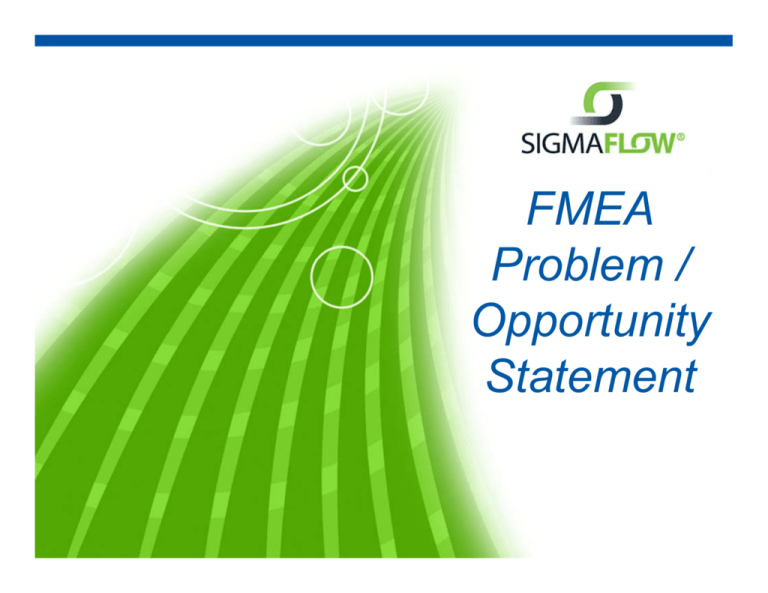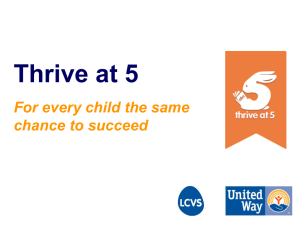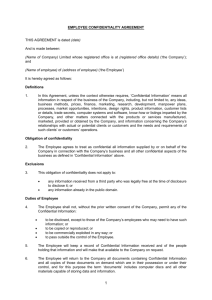
FMEA
Problem /
Opportunity
Statement
Problem/Opportunity Statement
Who
• FMEA Team
Leader
• Senior
Stakeholders
• Process
Owners
What
• SMART
Problem or
Opportunity
Statement
• Establish
Metrics
• Determine
Scope
Copyright © 2007 SigmaFlow. All rights reserved.
CONFIDENTIAL content, not to be redistributed without express SigmaFlow permission.
Why
• Undefined
problem will
produce an
undefined
solution.
• FMEA can
absorb
b b ti
time
and resources
want to make
sure it is
i
focused in the
right way.
Problem/ Opportunity Statement
An undefined problem has an infinite number of
solutions.
solutions
-Robert A. Humphrey
• To make sure we have the greatest likelihood of
success from our FMEA we must be able to
determine what would define success.
• In order to define success we must know
specifically what problem or opportunity have we
made better. (and therefore assisted with a
business driver)
Copyright © 2007 SigmaFlow. All rights reserved.
CONFIDENTIAL content, not to be redistributed without express SigmaFlow permission.
Problem/ Opportunity Statement
Specific
• Specific problems have a greater chance of getting
addressed. General problems/opportunities will produce
general solutions
Measurable
• Establish metrics to baseline existing performance and
the criteria that will be used to determine success.
Attainable
• Set the scope of the metrics to the right level. Don’t boil
the ocean. Make sure the project and project team can
achieve results.
Realistic
• To be realistic a problem/opportunity statement should be
something that the team is both willing and able to
complete.
Tangible
g
• The Problem/Opportunity will come to life when your
project team contains stakeholders who have
experienced the issue for themselves
themselves.
Copyright © 2007 SigmaFlow. All rights reserved.
CONFIDENTIAL content, not to be redistributed without express SigmaFlow permission.
Specific
p
• Specific problems have a greater chance of getting
addressed. General problems/opportunities will produce
general solutions
p
• To be Specific
we should be able to answer these
questions:
Who:
Who is involved?
What: What do I want to accomplish?
Where: Identify a location.
When: Establish a time frame.
Which: Identify requirements and constraints.
Why:
Specific reasons
reasons, purpose or benefits of solving
the problem or opportunity.
Copyright © 2007 SigmaFlow. All rights reserved.
CONFIDENTIAL content, not to be redistributed without express SigmaFlow permission.
Measurable
• Establish metrics to baseline existing performance and
success
the criteria that will be used to determine success.
One of the most critical
steps in starting your
FMEA will be making
sure you have a
measure to judge the
impact of your actions.
A metric
Any
t i can b
be
acceptable.
Just ask yourself “ If my success is determined by one measure
What would it be?”
Copyright © 2007 SigmaFlow. All rights reserved.
CONFIDENTIAL content, not to be redistributed without express SigmaFlow permission.
Attainable
• Set the scope of the metrics to the right level. Don’t boil
project
j
and p
project
j
team can
the ocean. Make sure the p
achieve results.
Balancing the scope of
your FMEA will help
your team
determine that “just
right”
i ht” b
balance.
l
T
To
wide and too much
time is spent in
identification not
action, too narrow
and the right issues
are not identified.
g
g the time and
How wide should I investigate
without sacrificing
resources to take action on the issues we identify?
Copyright © 2007 SigmaFlow. All rights reserved.
CONFIDENTIAL content, not to be redistributed without express SigmaFlow permission.
Realistic
Stakeholder
Analysis will assist
us in understanding
opposition and
supportt off our
study. Business
willingness to
conduct the study
and resources to be
able to complete the
study are evidence
of the probability of
making changes
based on the action
steps.
Copyright © 2007 SigmaFlow. All rights reserved.
CONFIDENTIAL content, not to be redistributed without express SigmaFlow permission.
• To be realistic a problem/opportunity statement should be
something that the team is both willing and able to
complete.
Tangible
• The Problem/Opportunity will come to life when your
project
team contains stakeholders who have
p
j
experienced the issue for themselves.
A picture is worth a thousand words…
Experience is worth a million….
The involvement of stakeholders who
have intimate knowledge of the process
will help you identify the Failure Modes,
Effects, Causes, Controls and Actions to
be taken. Without their experience the
exercise is p
purely
y theory…..
y
Copyright © 2007 SigmaFlow. All rights reserved.
CONFIDENTIAL content, not to be redistributed without express SigmaFlow permission.







